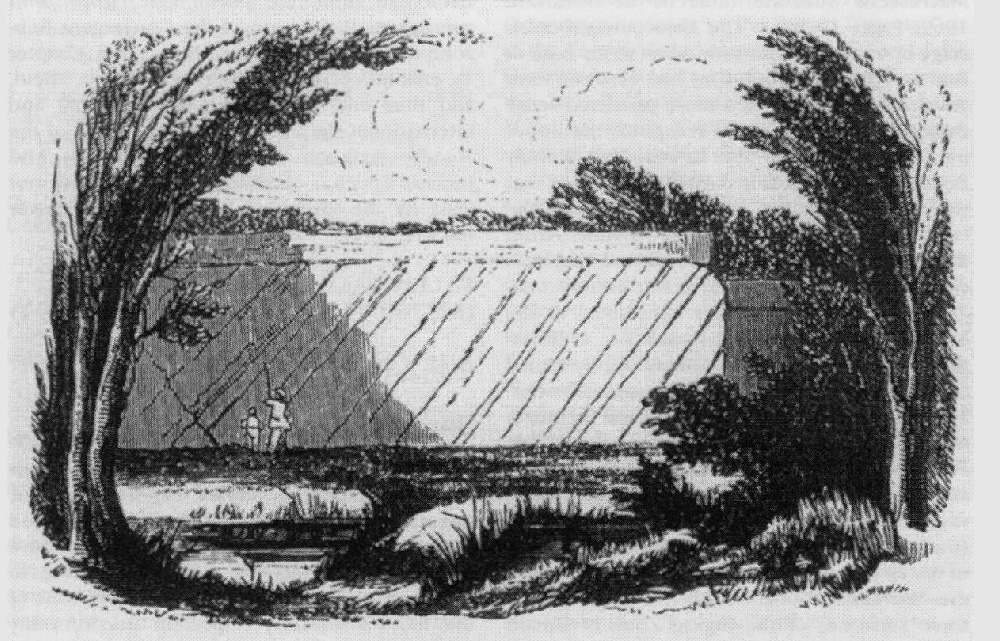Vallis Vale, Somerset
B.M. Cox
Introduction
The sections at the GCR site known as 'Vallis Vale' near Frome, Somerset, expose the major angular unconformity between Jurassic and Carboniferous strata, which is a famous feature of the eastern Mendip Hills. According to Prosser and King (1999), they constitute 'one of the most historically important unconformity sites in the SSSI coverage'. Eroded by the Mells and Egford streams that join the River Frome just north of Frome, Vallis Vale is steep-sided and about 30 m deep (Macfadyen, 1970). Triassic (Rhaetian) and Lower Jurassic (
Description
The Middle Jurassic succession has been reported at a number of localities within the GCR site, which extends for over a kilometre in a crude Y-shape from Bedlam in the north-west to Hapsford in the north-east, and towards Egford in the south. The Jurassic beds dip very gently north-eastwards; those of the Carboniferous dip north-westwards at about 30° (Savage, 1977). The following section, including bed numbers, is based on that recorded by Richardson (1907a). It was measured on the central spur of high ground that runs southwards between Bedlam and Hapsford, and which forms the western side of Vallis Vale proper.
| Thickness (m) | |
| Inferior Oolite Formation | |
| 1: Limestone, ooidal, thinly bedded or flaggy | 2.75 |
| 2: Limestone | 0.35 |
| 3: Rubble | 0–0.05 |
| 4: Limestone, massive | 0.53 |
| 5: Rubble | 0–0.05 |
| 6: Limestone, massive | 0.40 |
| 7: Rubble | 0.05–0.10 |
| 8: Limestone, massive, rubbly at top and base, coarsely ooidal | 0.75 |
| 9: Clay | 0–0.05 |
| 10: Limestone, massive, relatively hard and forming prominent rib; chert fragments; Ctenostreon pectiniforme (Schlotheim) very common; Trichites fragments; pentacrinoid columnals; serpulids; rhynchonellid brachiopods | 0.48 |
| 11: Limestone with irregular clay partings forming three tiers; top tier bored and with encrusting oysters; brachiopods including Acanthothiris spinosa (Schlotheim) (common) and Stiphrothyris tumida (Davidson); echinoids including Acrosalenia, 'Cidaris', Clypeus, Holectypus and Trochotoma; bivalves including Pholadomya murchisoni (J. Sowerby) | 0.75 |
| 12: Marl, brown, earthy | 0.03–0.08 |
| 13: Limestone, yellowish, massive; poorly fossiliferous with rare bivalves (including Pseudolimea); brachiopods (including Acanthothiris); echinoids (including Clypeus and Pseudodiadema) | 1.20 |
| 14: Limestone, highly inclined, with evenly planed, bored and oyster-encrusted surface |
Interpretation
The Carboniferous Limestone exposed beneath the Middle Jurassic strata in the northern part of the site (as represented by the above section) is assigned to the
The eroded upper surface of the Carboniferous beds is remarkably flat and even, and is a product of a marine transgression in Late Bajocian times — an event that is recognized widely in southern and eastern England (see Chapter 3). Bradshaw and Cripps (1992) suggested that the sea-level rise and consequent transgression may have been initially matched or even exceeded in parts of the British area by epeirogenic upwarp. The Mendip area is the site of a well-known E-W-trending Palaeozoic structure (the Mendip ridge or 'axis' comprising at least four anticlinal folds arranged en echelon), which formed a 'high' or 'swell' in the Mesozoic Era (Welch, 1933; Green, 1992). In the eastern Mendip Hills, the unconformity surface is oyster-encrusted and conspicuously bored by organisms that colonized the rocky floor of the Late Bajocian (Inferior Oolite Formation) sea. The preserved fauna of this so-called 'rockground' is dominated by cemented and boring fixo-sessile benthos adapted to a high-energy environment (Bromley, 1975; Cole and Palmer, 1999). According to these authors, the fauna can be classified, according to their mode of life, into encrusters, borers and nestlers. The dominant encruster is the oyster Liostrea. The borers are represented by the club-shaped ichnospecies Gastrochaenolites, in which the bivalve Hiatella is often found nestling, and the cylindrical worm boring Trypanites. Gastropods, remains of which are occasionally found in the latter, are thought to have adopted a nestling habit or possibly were accidental occupants having fallen into the borings. The preserved Bajocian fauna is thus an in-situ life assemblage of low species-diversity. Vagrant and less robust species would probably have inhabited the rocky sea-floor but they did not survive as fossils (Cole and Palmer, 1999).
Richardson (1907a) assigned the Bajocian strata here to the
Conclusions
The sections in the Vallis Vale GCR site provide natural exposures of a major angular unconformity between Palaeozoic and Mesozoic rocks. At its maximum development, almost horizontal strata of Late Bajocian (Mid Jurassic) age overlie a planed and bored surface of more steeply dipping Dinantian (Early Carboniferous) strata. The unconformity represents a break of some 170 million years in Earth history. Known to the early writers on geology, the site has been widely reported in the literature for over 150 years and therefore has an important place in the history of geology as well as being of stratigraphical and palaeogeographical interest.

